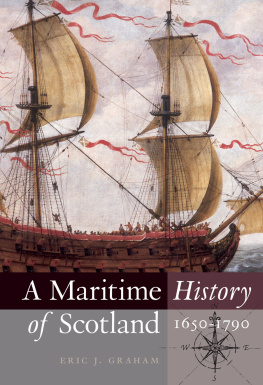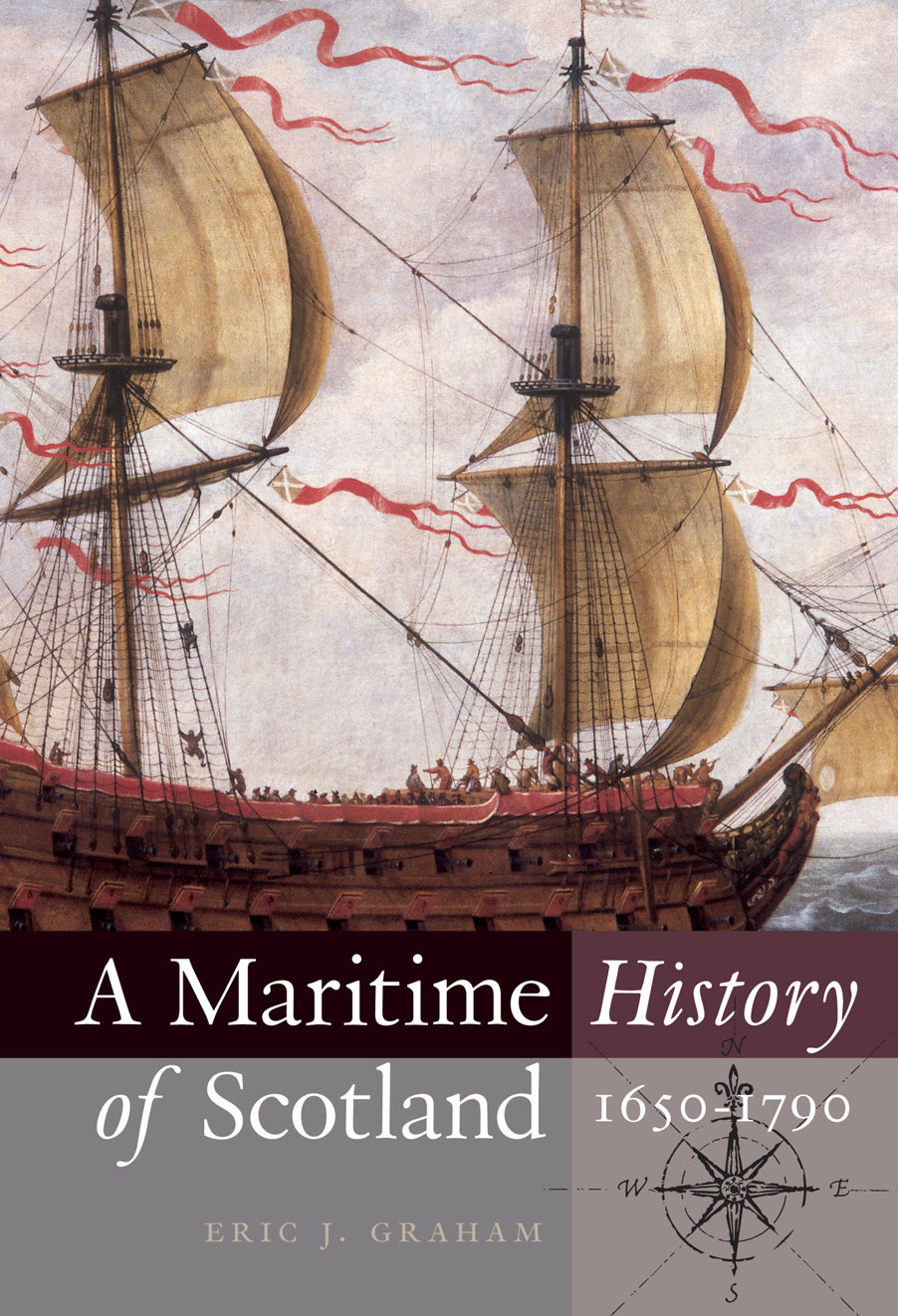The title page illustration is of
the seal of the High Court of Admiralty of Scotland
This edition first published in 2015 by
John Donald, an imprint of Birlinn Ltd
West Newington House
10 Newington Road
Edinburgh
EH9 1QS
www.birlinn.co.uk
Eric J. Graham, 2002
ISBN 978 1 788853 35 4
First published in 2002 by Tuckwell Press
British Library Cataloguing in Publication Data
A catalogue record for this book is available
on request from the British Library
Design by Mark Blackadder
Printed and bound in Britain by Short Run Press, Exeter
FIGURES
TABLES
I would like to express my gratitude to a host of like-minded individuals whose open-handed generosity has done so much to enrich this work. This circle of colleagues encompasses a spectrum of academics and maritime enthusiasts, many of whom have gifted their indispensable local knowledge to this study.
I am deeply indebted to Professor C. A. Whatley and Dr. G. Jackson for their unstinting support. My thanks also go to Dr. D. Starkey for his constructive comments and to Dr. D. Richardson, K. Beedham and the late M. M. Schofield whose combined work on the Liverpool Plantation Records was made available to me by the ESRC Data Archive. Likewise, to Professor H. C. Johansen for access to the Danish Sound Tolls database.
I am indebted to many libraries: the Aberdeen Public Library, Aberdeen Maritime Museum, Ayrshire Archives, British Library, Carnegie Library at Ayr, Dundee City Archives, Campbeltown Archives at Dunoon Library, Dumbarton Public Library, Hunterian Library of the University of Glasgow, Edinburgh City Library, Exeter University Library, Lloyds Register of Shipping, Mitchell Library, National Maritime Museum, National Archives of Scotland, National Library of Scotland, North Ayrshire Library, North Ayrshire Museum, Public Record/Office and the Watt Library at Greenock. I am also indebted to the Society of Nautical Research for a grant towards travelling expenses.
On a more personal note I would like to record my gratitude to: David Alston, Sheena Andrew, Tom Barclay, Frank & Rosemary Bigwood, Richard F. Dell, Michael Dun, Alan W. Graham Ian Hustwick, Jane Jamieson, Janet Kinloch, Bill Lane, Sue Mowat, Donald & Mary Petrie and Frances Wilkins for their generous access to their notes and resources. Also to I. L. Mackay and I. Ryland of HM Customs & Excise and Richard Dargie of Moray House for their support.
Lastly, I am indebted, as always, to my wife Jan Bateman for her unstinting support and encouragement throughout a period of research and write-up that extended far beyond all expectations.
ERIC J. GRAHAM
TYPES OF RIG, c. 1765: A. A LARGE SHIP-RIGGED WEST INDIAMAN; B. A SNOW-RIGGED HULL; C. A BRIG-RIGGED HULL. FROM FREDRIK AF CHAPMAN, ARCHITECTURA NAVALIS MERCATORIA (SWEDEN, 1768).
Types of seventeenth-and eighteenth-cent
ury Scottish vessels
Bark large open or partially decked seagoing trader, often with leeboards.
Birlin West Highland oared open boat capable of crossing major channels.
Brig or brigantine two-masted, square-rigged, wide-decked seagoing vessel of various sizes.
Bucker the general name for an armed two-masted lugger as first used by the smugglers of Buckie.
Buss decked fishing boat within 20-80 tons class as prescribed by the bounty rules which included fishing tackle and nets onboard. The larger hulls had a roller set into the bow gunwhale over which fishing tackle and floats were laid and retrieved.
Coble Small open boat used in inshore fishing and oared by four men or more if working further out. Capable of stepping a small sail in the right conditions.
Cutter single-masted vessel, fore and aft rigged, with sharp hull and extended bowsprit.
Doggar a two-masted Dutch offshore fishing boat.
Fluyt boat the standardised Dutch medium-sized bulk carrier (up to 600 tons), often flat-bottomed with severe tumble-home and very high narrow stern.
Gabbart shallow-draft sailing lighter with leeboards suitable for rivers and estuaries.
Galley A corruption of the term galleon (as in high-sterned, three-masted, oceangoing, armed sailing vessel). This use of this term in Scotland died out by the mid-eighteenth century.
Jager Dutch supply ship to the grand fisheries. Also used as hospital ship or to run high-priced early-season catches back to market.
Lugger small two-masted vessel with lug square sails that could be set to work high to windward. Much favoured by smugglers and privateers.
Pink narrow-decked, round-sterned Dutch bulk carrier with a flat floor interior.
Schooner two-masted vessel, fore and aft rigged, commonly used in American and West Indian waters.
Shallop small, fast, two-masted open or partially deck vessel, usually schooner-rigged, used in fishing or dispatches.
Ship three-masted, all square sail, vessel.
Sixtereen High-prowed open fishing boat oared by six men used in Shetland and Orkney for offshore line fishing and inter-island communication.
Sloop general term for single-masted vessels without cutter bow or bowsprit.
Snow variation of brig where the rear mast had a separate upright from which to set the mizzen sail.
Wherry broad-decked, shallow-draft hull with lee boards and low freeboard suitable for the deployment of sweeps (large oars).
Yacht a decked hull with superior passenger accommodation, originally of Dutch design, that was used to convey an important person or persons.
Customs terms
Customs precinct stretch of shoreline under the supervisor of a Collector.
Head port the reporting port of the precinct.
Creek general term used to describe other smaller harbours or anchorages within the precinct.
Collector Customs officer directly responsible to Edinburgh for the precinct.
Comptroller second-in-line to Collector and responsible for accounts.
Tidesurveyor Customs officer in charge of tidewaiters.
Tidewaiter Customs officer put onboard vessels on entry or departure.
Landsurveyor Customs officer in charge of landwaiters and landcarriagemen.




















